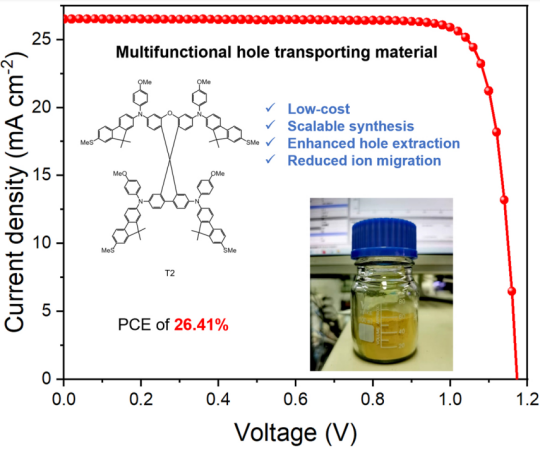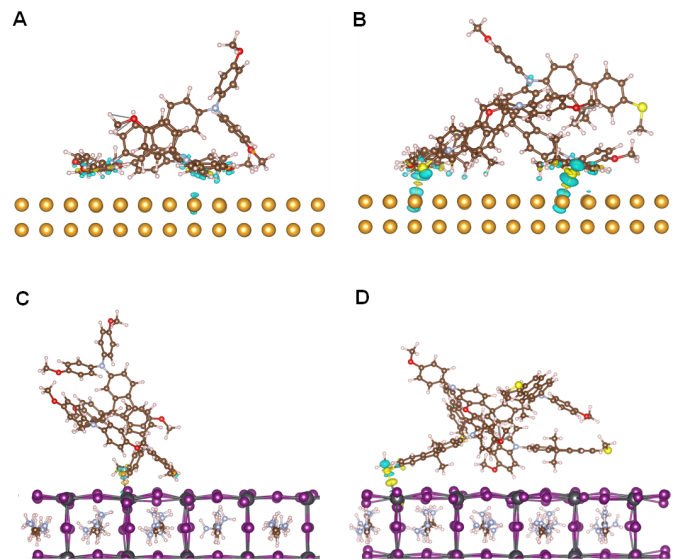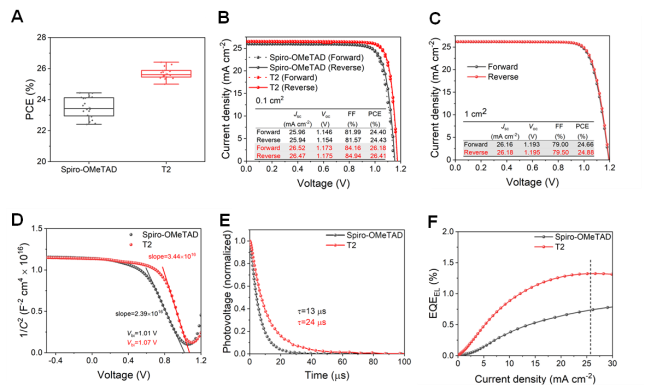The team led by Professor Yi Chenyi from the Department of Electrical Engineering and Applied Electronics (EEA) at Tsinghua University achieved a record-breaking efficiency of 26.41% for perovskite solar cells by developing new hole transport materials combined with vacuum-deposited perovskite thin films.
In the field of photovoltaic technology, perovskite solar cells (PSCs) have garnered widespread attention due to their outstanding power conversion efficiency (PCE) and low cost. Hole transport materials (HTMs) are crucial for the optoelectronic performance and long-term stability of PSCs. Their main function is to extract photogenerated holes and prevent electron recombination, thereby suppressing charge recombination. Additionally, they can act as an intermediate layer to block the diffusion of ions between the metal electrode and the perovskite.
The most widely used hole transport material, 2,2′,7,7′-Tetra(N,N-di-p-methoxyphenylamine)-9,9′-spirobifluorene (spiro-OMeTAD), although efficient in hole extraction and well-matched in energy levels with perovskite, has a complex synthesis and purification process, making it costly and unsuitable for large-scale industrial applications. Moreover, common additives such as lithium bis (trifluoromethanesulfonyl) imide (Li-TFSI) and 4- tert- butylpyridine introduced into spiro-OMeTAD lead to pinholes in the thin film. These holes provide channels for the diffusion of ions from the perovskite and metal atoms from the back electrode, leading to defect formation and adversely affecting the long-term stability of the device.

Physical photos and characteristics of T2, as well as efficiency testing curves of perovskite solar cells prepared based on T2

Density functional theory (DFT) calculations of differential charge density for the adsorption of Spiro-OMeTAD (left column) and T2 (right column) on gold (top row) and perovskite (bottom row)
To address these issues, Professor Yi Chenyi’s team at Tsinghua University designed and synthesized a new multifunctional hole transport material, T2 (chemical structure shown in the figure). This material can be synthesized from low-cost commercial raw materials with high yield, suitable for large-scale production (synthesis of over 15 grams in a single run has been achieved), and its raw material cost is only one-thirtieth of the price of commonly used spiro-OMeTAD. Compared to spiro-OMeTAD, T2 not only has better energy level alignment with perovskite but also overlaps with the local density of states (LDOS) of some electronic states in the perovskite layer, which enhances charge extraction capability and reduces voltage losses. T2 forms a pinhole-free HTM layer with strong binding with the dopant Li-TFSI. Furthermore, the sulfur atoms in T2 can interact with under-coordinated lead atoms at the perovskite/HTM interface, passivating defects and inhibiting ion diffusion; meanwhile, sulfur atoms can also coordinate with metal atoms at the HTM/electrode interface, effectively suppressing metal migration, thereby improving the efficiency and stability of PSCs.

Chemical structures and energy level positions of Spiro-OMeTAD and T2, as well as photos of perovskite solar cells and components prepared based on T2

Test results of perovskite solar cells prepared based on Spiro-OMeTAD and T2
By combining T2 with sequentially vacuum-deposited perovskite films, the researchers achieved a power conversion efficiency (PCE) of 26.41% on PSCs with a 0.1cm² aperture area (certified efficiency of 26.21%), and a certified efficiency of 24.88% on PSCs with a 1.0cm² aperture area. In addition, the researchers also achieved a small module with an efficiency of 21.45% (effective illuminated area of 14.4cm²). The maximum power point tracking (MPPT) time of T80 for unencapsulated T2-based devices was 600 hours, four times that of spiro-OMeTAD-based PSCs. T2-based PSCs also demonstrated good long-term device stability during storage (maintaining 95% of the initial PCE after 2800 hours of storage under air conditions with a relative humidity of 10% and no encapsulation) and thermal treatment (maintaining 84% of the initial PCE after heating at 60°C for 1500 hours).
The record-breaking efficiency, good stability, low cost, and scalability of T2-based hole transport materials demonstrate their enormous potential in PSC applications. This multifunctional hole transport material design strategy provides valuable experience and guidance for future material development. This is also the first time that the efficiency of vacuum-deposited perovskite solar cells has surpassed that of traditional solution methods, demonstrating the tremendous development potential of this approach.
Recently, the above research results were published in the international academic journal “Joule” under the title “Highly efficient and stable perovskite solar cells via a multifunctional hole transporting material”. The co-first authors of the paper are doctoral students Zhou Junjie, Tan Liguo, Liu Yue, and Li Hang from EEA; the corresponding author is Yi Chenyi; collaborators include Hua Ruimao from the Department of Chemistry at Tsinghua University, Wolfgang Tress from the Swiss Federal Institute of Technology in Zurich, and Simone Meloni from the University of Ferrara, Italy.
This research was supported by the National Natural Science Foundation of China’s Enterprise Innovation Development Joint Fund Project, the National Key Research and Development Program, the Independent Research Program of Tsinghua University, EEA’s Independent Research Project of Tsinghua University, China Postdoctoral Science Foundation and the “Shuimu Scholar” Program of Tsinghua University.
Article link:
https://www.sciencedirect.com/science/article/pii/S2542435124001028

















 News & Events
News & Events